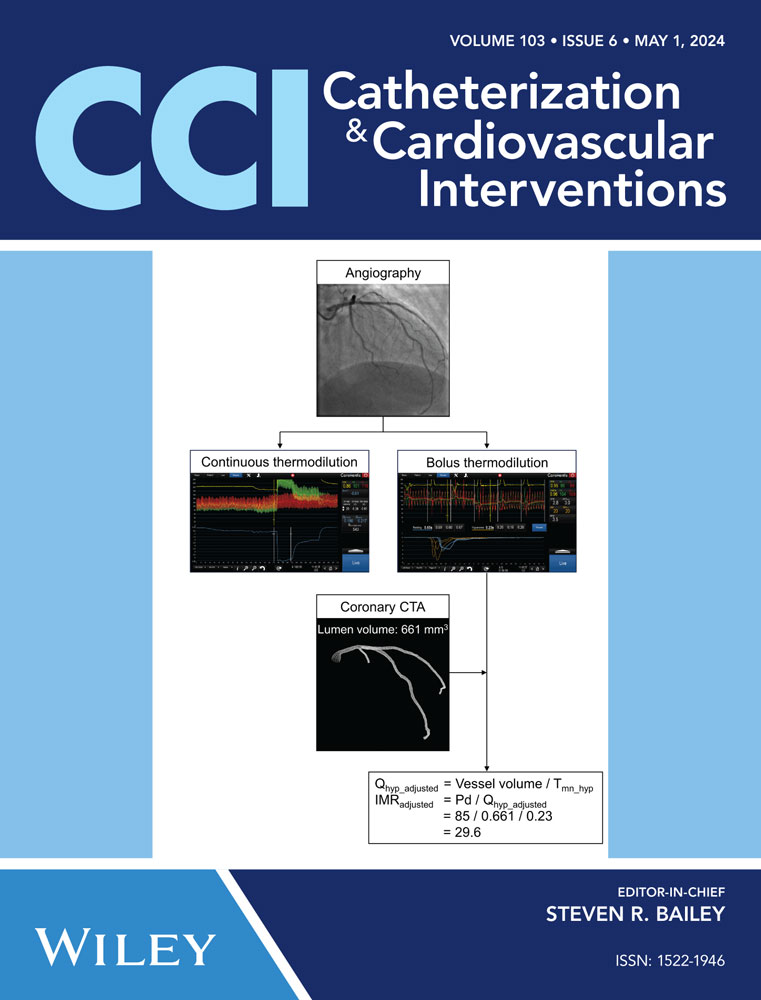Clinical characteristics and outcomes of alcohol septal ablation in the era of transcatheter valve interventions
Abstract
Background
The clinical efficacy and safety of alcohol septal ablation (ASA) for obstructive hypertrophic cardiomyopathy (HCM) have been well-established; however, less is known about outcomes in patients undergoing preemptive ASA before transcatheter mitral valve replacement (TMVR).
Aims
The goal of this study is to characterize the procedural characteristics and examine the clinical outcomes of ASA in both HCM and pre-TMVR.
Methods
This retrospective study compared procedural characteristics and outcomes in patient who underwent ASA for HCM and TMVR.
Results
In total, 137 patients were included, 86 in the HCM group and 51 in the TMVR group. The intraventricular septal thickness (mean 1.8 vs. 1.2 cm; p < 0.0001) and the pre-ASA LVOT gradient (73.6 vs. 33.8 mmHg; p ≤ 0.001) were higher in the HCM group vs the TMVR group. The mean volume of ethanol injected was higher (mean 2.4 vs. 1.7 cc; p < 0.0001). The average neo-left ventricular outflow tract area increased significantly after ASA in the patients undergoing TMVR (99.2 ± 83.37 mm2 vs. 196.5 ± 114.55 mm2; p = <0.0001). The HCM group had a greater reduction in the LVOT gradient after ASA vs the TMVR group (49.3 vs. 18 mmHg; p = 0.0040). The primary composite endpoint was higher in the TMVR group versus the HCM group (50.9% vs. 25.6%; p = 0.0404) and had a higher incidence of new permanent pacemaker (PPM) (25.5% vs. 18.6%; p = 0.3402). The TMVR group had a higher rate of all-cause mortality (9.8% vs. 1.2%; p = 0.0268).
Conclusions
Preemptive ASA before TMVR was performed in patients with higher degree of clinical comorbidities, and correspondingly is associated with worse short-term clinical outcomes in comparison to ASA for HCM patients. ASA before TMVR enabled percutaneous mitral interventions in a small but significant minority of patients that would have otherwise been excluded. The degree of LVOT and neoLVOT area increase is significant and predictable.
CONFLICTS OF INTEREST STATEMENT
Dr. Frisoli is a proctor for Edwards Lifesciences, Abbott, Boston Scientific, and Medtronic. Dr. Villablanca is a consultant for Edwards Lifesciences and Teleflex. Dr. B O'Neill is a consultant to and receives research support from Edwards Lifesciences. Dr. Wang is a consultant to Edwards Lifesciences, Abbott, Neochord, Boston Scientific, and receives research grant support from Boston Scientific assigned to employer Henry Ford Health System. Dr. W O'Neill has served as a consultant for Abiomed, Edwards Lifesciences, Medtronic, Boston Scientific, Abbott Vascular, and St. Jude Medical; and serves on the Board of Directors of Neovasc Inc. The remaining authors declare no conflict of interest.
Open Research
DATA AVAILABILITY STATEMENT
The data that support the findings of this study are available from the corresponding author upon reasonable request.




